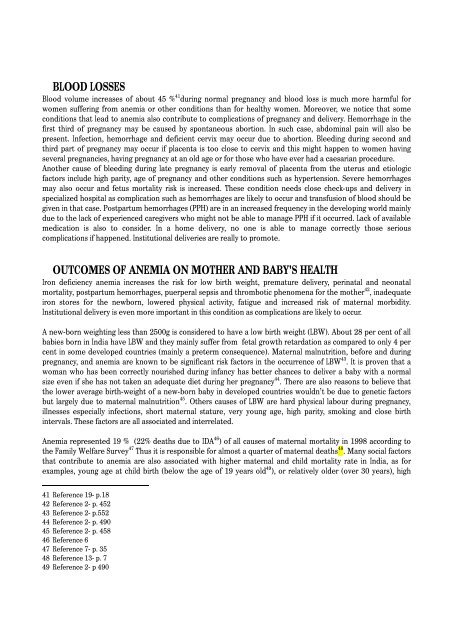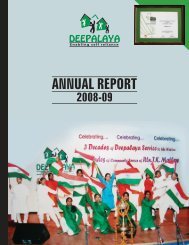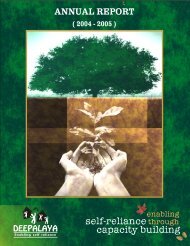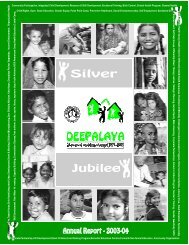Report 2011 - Deepalaya
Report 2011 - Deepalaya
Report 2011 - Deepalaya
Create successful ePaper yourself
Turn your PDF publications into a flip-book with our unique Google optimized e-Paper software.
BLOOD LOSSES<br />
Blood volume increases of about 45 % 41 during normal pregnancy and blood loss is much more harmful for<br />
women suffering from anemia or other conditions than for healthy women. Moreover, we notice that some<br />
conditions that lead to anemia also contribute to complications of pregnancy and delivery. Hemorrhage in the<br />
first third of pregnancy may be caused by spontaneous abortion. In such case, abdominal pain will also be<br />
present. Infection, hemorrhage and deficient cervix may occur due to abortion. Bleeding during second and<br />
third part of pregnancy may occur if placenta is too close to cervix and this might happen to women having<br />
several pregnancies, having pregnancy at an old age or for those who have ever had a caesarian procedure.<br />
Another cause of bleeding during late pregnancy is early removal of placenta from the uterus and etiologic<br />
factors include high parity, age of pregnancy and other conditions such as hypertension. Severe hemorrhages<br />
may also occur and fetus mortality risk is increased. These condition needs close check-ups and delivery in<br />
specialized hospital as complication such as hemorrhages are likely to occur and transfusion of blood should be<br />
given in that case. Postpartum hemorrhages (PPH) are in an increased frequency in the developing world mainly<br />
due to the lack of experienced caregivers who might not be able to manage PPH if it occurred. Lack of available<br />
medication is also to consider. In a home delivery, no one is able to manage correctly those serious<br />
complications if happened. Institutional deliveries are really to promote.<br />
OUTCOMES OF ANEMIA ON MOTHER AND BABY'S HEALTH<br />
Iron deficiency anemia increases the risk for low birth weight, premature delivery, perinatal and neonatal<br />
mortality, postpartum hemorrhages, puerperal sepsis and thrombotic phenomena for the mother 42 , inadequate<br />
iron stores for the newborn, lowered physical activity, fatigue and increased risk of maternal morbidity.<br />
Institutional delivery is even more important in this condition as complications are likely to occur.<br />
A new-born weighting less than 2500g is considered to have a low birth weight (LBW). About 28 per cent of all<br />
babies born in India have LBW and they mainly suffer from fetal growth retardation as compared to only 4 per<br />
cent in some developed countries (mainly a preterm consequence). Maternal malnutrition, before and during<br />
pregnancy, and anemia are known to be significant risk factors in the occurrence of LBW 43 . It is proven that a<br />
woman who has been correctly nourished during infancy has better chances to deliver a baby with a normal<br />
size even if she has not taken an adequate diet during her pregnancy 44 . There are also reasons to believe that<br />
the lower average birth-weight of a new-born baby in developed countries wouldn’t be due to genetic factors<br />
but largely due to maternal malnutrition 45 . Others causes of LBW are hard physical labour during pregnancy,<br />
illnesses especially infections, short maternal stature, very young age, high parity, smoking and close birth<br />
intervals. These factors are all associated and interrelated.<br />
Anemia represented 19 % (22% deaths due to IDA 46 ) of all causes of maternal mortality in 1998 according to<br />
the Family Welfare Survey 47 Thus it is responsible for almost a quarter of maternal deaths 48 . Many social factors<br />
that contribute to anemia are also associated with higher maternal and child mortality rate in India, as for<br />
examples, young age at child birth (below the age of 19 years old 49 ), or relatively older (over 30 years), high<br />
41 Reference 19- p.18<br />
42 Reference 2- p. 452<br />
43 Reference 2- p.552<br />
44 Reference 2- p. 490<br />
45 Reference 2- p. 458<br />
46 Reference 6<br />
47 Reference 7- p. 35<br />
48 Reference 13- p. 7<br />
49 Reference 2- p 490







